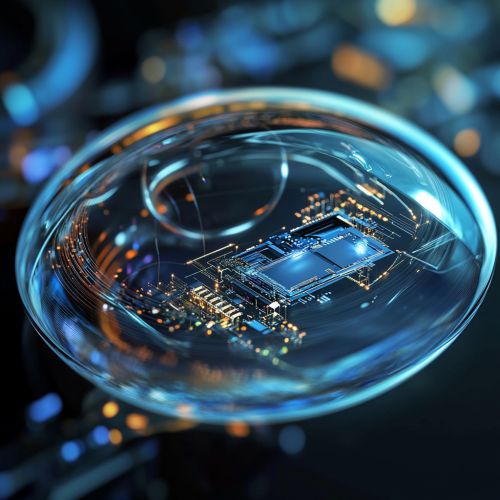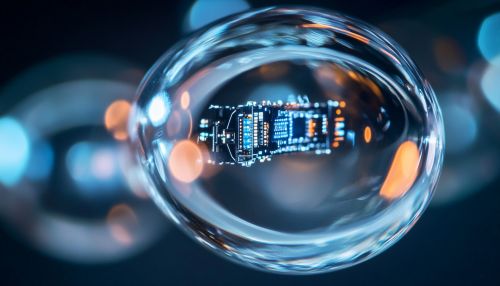@smart contact lens technology
Introduction
Smart contact lens technology represents a significant advancement in the field of wearable devices, integrating sophisticated electronics into a form factor as small as a contact lens. These lenses are designed to provide augmented reality (AR) capabilities, health monitoring, and improved vision correction. The development of smart contact lenses involves interdisciplinary collaboration across fields such as biotechnology, nanotechnology, and optics.
Historical Background
The concept of smart contact lenses can be traced back to the early 21st century when researchers began exploring the integration of electronic components into contact lenses. Initial prototypes focused on embedding sensors for glucose monitoring, primarily aimed at diabetic patients. Over time, advancements in microelectronics and materials science have enabled the development of more sophisticated lenses capable of a broader range of functions.
Technical Components
Smart contact lenses are composed of several key components:
Sensors
Sensors are integral to the functionality of smart contact lenses. These may include:
- **Glucose Sensors**: Utilized for continuous glucose monitoring by analyzing tear fluid.
- **Intraocular Pressure Sensors**: Used to monitor eye pressure, aiding in the management of glaucoma.
- **Environmental Sensors**: Detect external conditions such as light intensity and UV exposure.
Display Technology
AR capabilities in smart contact lenses are achieved through micro-displays embedded within the lens. These displays project images directly onto the retina, providing a seamless overlay of digital information onto the real world. The technology often involves OLED or microLED displays due to their low power consumption and high brightness.
Power Supply
Powering smart contact lenses is a significant challenge due to their small size. Current solutions include:
- **Microbatteries**: Rechargeable batteries that provide power for short durations.
- **Wireless Power Transfer**: Utilizing inductive charging or radio frequency energy harvesting to power the lenses without direct contact.
Communication Systems
Smart contact lenses require robust communication systems to transmit data to external devices. This is typically achieved through Bluetooth or Near Field Communication (NFC) technologies, allowing for real-time data exchange with smartphones or other wearable devices.
Applications
Smart contact lenses have a wide range of potential applications:
Medical Monitoring
One of the primary applications is in the field of health monitoring. By continuously measuring physiological parameters such as glucose levels and intraocular pressure, smart contact lenses can provide valuable data for managing chronic conditions like diabetes and glaucoma.
Vision Enhancement
In addition to standard vision correction, smart contact lenses can offer enhanced vision capabilities. This includes adjustable focus, night vision, and AR overlays that provide real-time information about the user's surroundings.
Augmented Reality
Smart contact lenses are poised to revolutionize AR by offering a more natural and immersive experience compared to traditional AR glasses. Applications range from navigation assistance to real-time translation and facial recognition.
Sports and Fitness
Athletes can benefit from smart contact lenses by accessing real-time performance metrics and environmental data. This can aid in optimizing training and improving safety by monitoring hydration levels and UV exposure.


Challenges and Limitations
Despite their potential, smart contact lenses face several challenges:
Miniaturization
The integration of complex electronics into a lens small enough to be worn comfortably remains a significant technical hurdle. Advances in nanofabrication and materials are crucial to overcoming this challenge.
Biocompatibility
Ensuring that the materials used in smart contact lenses are biocompatible is essential to prevent adverse reactions in the eye. This requires extensive testing and development of new materials that are both safe and effective.
Power Management
Developing efficient power management systems that can sustain the lens's functionality without frequent recharging is critical. Research into energy-efficient components and alternative power sources is ongoing.
Data Privacy
The collection and transmission of sensitive health data raise concerns about privacy and security. Robust encryption and data protection measures are necessary to safeguard user information.
Future Prospects
The future of smart contact lens technology is promising, with ongoing research aimed at expanding their capabilities and improving their practicality. Potential developments include:
- **Advanced AR Features**: Incorporating more sophisticated AR functionalities, such as gesture recognition and eye-tracking.
- **Integration with AI**: Leveraging artificial intelligence to provide personalized insights and recommendations based on the data collected by the lenses.
- **Broader Medical Applications**: Expanding the range of health parameters that can be monitored, such as blood pressure and cholesterol levels.
